- What is Calceolaria?
- Home Care Tips for Calceolaria
- Light and Temperature
- Watering
- Potting and Soil
- Fertilizer
- Pruning
- Pest Control
- Managing Humidity
- Different types of Calceolaria Plants Calceolaria plants come in a wide variety of types, each with its own unique characteristics and growing requirements. Here are some popular types of Calceolaria plants: 1. Calceolaria Herbeohybrida Also known as the Pocketbook plant or Slipper flower, Calceolaria Herbeohybrida is the most commonly cultivated type of Calceolaria. It features bright, vibrant flowers in shades of yellow, orange, red, and pink. These plants are typically grown as annuals and are popular choices for flower beds, containers, and hanging baskets. 2. Calceolaria Uniflora Calceolaria Uniflora, also known as the Calceolaria Slipper Orchid, is a more delicate and exotic type of Calceolaria. It features small, intricate flowers that resemble a slipper or orchid. These plants are typically grown as perennials and are best suited for indoor cultivation or protected outdoor areas with mild climates. 3. Calceolaria Integrifolia Calceolaria Integrifolia, also known as the Calceolaria Gold-dust, is a compact and bushy type of Calceolaria. It features small, rounded leaves covered in golden-yellow spots, giving it a unique and eye-catching appearance. These plants are typically grown as perennials and are well-suited for rock gardens, borders, and containers. 4. Calceolaria Insignis Calceolaria Insignis, also known as the Calceolaria Jungle Queen, is a taller and more upright type of Calceolaria. It features large, showy flowers in shades of yellow, orange, and red. These plants are typically grown as annuals and are great choices for adding height and color to flower beds and borders. 5. Calceolaria Rugosa Calceolaria Rugosa, also known as the Calceolaria Slipperwort, is a wild species of Calceolaria that is native to South America. It features small, yellow flowers with a distinctively wrinkled appearance. These plants are typically grown as perennials and are best suited for rock gardens, alpine gardens, and naturalized areas. 6. Calceolaria Crenatiflora Calceolaria Crenatiflora, also known as the Calceolaria Lace-flower, is a delicate and lace-like type of Calceolaria. It features small, white or yellow flowers that are intricately patterned and fringed. These plants are typically grown as perennials and are popular choices for borders, containers, and hanging baskets. These are just a few examples of the many types of Calceolaria plants available. Each type offers its own unique beauty and charm, so no matter which one you choose, you are sure to enjoy the stunning flowers and lovely foliage that Calceolaria plants have to offer. Popular Varieties of Calceolaria Calceolaria, also known as slipper flower, is a beautiful plant that comes in a variety of colors and forms. Here are some of the popular varieties: Calceolaria Herbeohybrida: This is the most common type of calceolaria. It features bright, vibrant flowers in a wide range of colors including yellow, orange, red, and pink. Calceolaria Uniflora: Also known as the Chilean Slipper Flower, this variety is native to the mountains of Chile. It has small, yellow flowers with distinct pouch-like shapes. Calceolaria crenatiflora: This variety is native to the Andes Mountains and features flowers in shades of yellow, orange, and red. The flowers have a unique fringed edge that adds to their beauty. Calceolaria integrifolia: Native to Argentina, this variety has flowers in shades of yellow and orange. It is known for its large, showy blooms and compact growth habit. Calceolaria arachnoidea: Also known as Woolly Slipper Flower, this variety has flowers that resemble small, fluffy balls. The flowers are usually yellow or orange in color. These are just a few examples of the many varieties of calceolaria available. Each variety has its own unique characteristics and care requirements, so be sure to choose one that suits your gardening style and environment. Calceolaria for Indoor Gardening Calceolaria, also known as slipper flower or pocketbook plant, is a popular choice for indoor gardening. With its vibrant and unique flowers, it adds a touch of color and charm to any indoor space. Here’s a guide to growing and caring for Calceolaria plants indoors. Light Calceolaria plants thrive in bright, indirect light. They prefer a location near a window that receives plenty of sunlight but avoid direct sunlight as it can scorch their delicate leaves. If your indoor space doesn’t receive sufficient natural light, you can supplement it with artificial grow lights. Temperature Calceolaria plants prefer cooler temperatures ranging from 50°F to 65°F (10°C to 18°C). They are not tolerant of extreme heat, so avoid placing them near heating vents or radiators. Maintaining a moderate temperature will help the plants thrive and prevent them from wilting. Watering Proper watering is essential for the health of Calceolaria plants. They prefer to be kept consistently moist, but not waterlogged. Allow the top inch of soil to dry out slightly before watering again. Be careful not to overwater as it can lead to root rot. Fertilizer Calceolaria plants benefit from regular fertilization during the growing season. Use a balanced, water-soluble fertilizer and dilute it to half-strength. Fertilize every two weeks to provide the necessary nutrients for healthy growth and vibrant flowers. Humidity Calceolaria plants appreciate higher humidity levels. To increase humidity around the plants, you can place a tray filled with water near them or use a humidifier. Misting the foliage with room temperature water also helps to maintain humidity. Propagating Calceolaria plants can be propagated by taking stem cuttings. Choose a healthy, non-flowering stem and cut it just below a node. Remove the lower leaves from the cutting and dip the cut end into rooting hormone. Plant the cutting in a well-draining potting mix and keep it consistently moist. After a few weeks, roots will develop, and you can transplant the cutting into its own pot. Common Varieties There are several different varieties of Calceolaria available for indoor gardening. Some popular choices include: Calceolaria arachnoidea: This variety has unusual web-like flowers and is known for its striking appearance. Calceolaria crenatiflora: With its vibrant red and yellow flowers, this variety is a standout in any indoor garden. Calceolaria uniflora: This compact variety produces small, dainty flowers and is perfect for smaller indoor spaces. Conclusion Calceolaria plants are a beautiful addition to any indoor garden. With the right care and conditions, they can thrive and reward you with their colorful flowers. Remember to provide them with the appropriate light, temperature, water, and humidity to ensure their success. Enjoy the beauty of Calceolaria plants in your indoor space! Calceolaria for Outdoor Landscaping If you’re looking to add a pop of color and unique texture to your outdoor landscape, Calceolaria plants are a fantastic choice. These vibrant flowering plants are sure to catch the eye and create a stunning visual display in any garden or landscape design. Plant Types Calceolaria plants come in various varieties, each offering its own unique characteristics. Some popular types that are commonly used for outdoor landscaping include: Calceolaria integrifolia: This variety produces large, showy flowers in shades of yellow, orange, and red. It is known for its long flowering period and hardy nature. Calceolaria herbeohybrida: Also known as pocketbook flower, this type features distinctive pouch-like flowers in bright colors such as yellow, orange, and pink. It is a popular choice for adding a touch of whimsy to outdoor landscapes. Calceolaria crenatiflora: This variety boasts flowers with frilly edges, creating a unique and eye-catching look. Colors range from yellow and orange to red and purple. Outdoor Care When growing Calceolaria outdoors, it’s important to consider their light, water, and soil requirements. Here are some key care tips: Light: Calceolaria plants thrive in partial shade or filtered sunlight. Avoid direct, intense sunlight, as it can scorch the leaves. Water: These plants prefer consistently moist but well-drained soil. Water regularly, especially during hot weather, but be careful not to overwater. Soil: Calceolaria plants prefer a well-draining soil that is rich in organic matter. A mix of peat moss, compost, and perlite can provide the perfect growing medium. Landscaping Ideas Calceolaria plants can be used in various ways to enhance your outdoor landscape design. Here are some ideas: Create colorful borders: Plant Calceolaria along walkways or around garden beds to add vibrant color and create a beautiful border. Container gardening: Grow Calceolaria in decorative pots or containers and place them strategically around your outdoor space for an instant burst of color. Rock gardens: These plants are well-suited for rock gardens, thanks to their ability to thrive in well-draining soils and their compact growth habit. Combine with other plants: Pair Calceolaria with other flowers, grasses, or shrubs that complement their colors and textures for a visually appealing landscape. Remember, Calceolaria plants are not frost-tolerant, so it’s important to protect them during the winter months or consider them as annuals in colder climates. With proper care and placement, Calceolaria can be a stunning addition to any outdoor landscaping project. Q&A: What is Calceolaria? Calceolaria is a flowering plant that belongs to the Scrophulariaceae family. It is commonly known as slipper flower or pocketbook flower due to its unique shape. What are the types of Calceolaria? There are several types of Calceolaria, including Calceolaria herbeohybrida, which is a popular houseplant, and Calceolaria uniflora, which is commonly found in the Andes Mountains of South America. What are the care tips for Calceolaria? To take care of Calceolaria, it is important to place it in a bright location with indirect sunlight. It requires well-draining soil and regular watering. The plant should be kept moist but not waterlogged. It also benefits from regular feeding with a balanced fertilizer. Can Calceolaria be grown indoors? Yes, Calceolaria can be grown indoors. It is a popular houseplant due to its colorful flowers and compact size. However, it requires specific care, including proper lighting and watering, to thrive indoors. How often should I water Calceolaria? Calceolaria should be watered regularly, keeping the soil moist but not overly wet. It is important to avoid both underwatering and overwatering, as it can lead to root rot or wilting of the plant. Are there any common problems or pests that affect Calceolaria? Yes, Calceolaria can be susceptible to pests such as aphids, whiteflies, and mealybugs. It can also be prone to diseases like powdery mildew and botrytis. Regular inspection and proper hygiene can help prevent and control these problems. What are some popular varieties of Calceolaria? Some popular varieties of Calceolaria include Calceolaria integrifolia, which has yellow flowers, and Calceolaria corymbosa, which has red and yellow flowers. Other varieties like Calceolaria mexicana and Calceolaria uniflora also have their own unique characteristics. Video: How To Prune Tomato Plants For Maximum Yield & Bigger Tomatoes – Organic Vegetable Garden in Arizona
- Different types of Calceolaria Plants
- 1. Calceolaria Herbeohybrida
- 2. Calceolaria Uniflora
- 3. Calceolaria Integrifolia
- 4. Calceolaria Insignis
- 5. Calceolaria Rugosa
- 6. Calceolaria Crenatiflora
- Popular Varieties of Calceolaria
- Calceolaria for Indoor Gardening
- Light
- Temperature
- Watering
- Fertilizer
- Humidity
- Propagating
- Common Varieties
- Conclusion
- Calceolaria for Outdoor Landscaping
- Plant Types
- Outdoor Care
- Landscaping Ideas
- Q&A:
- What is Calceolaria?
- What are the types of Calceolaria?
- What are the care tips for Calceolaria?
- Can Calceolaria be grown indoors?
- How often should I water Calceolaria?
- Are there any common problems or pests that affect Calceolaria?
- What are some popular varieties of Calceolaria?
- Video: How To Prune Tomato Plants For Maximum Yield & Bigger Tomatoes – Organic Vegetable Garden in Arizona
Calceolaria, also known as slipper flower, is a beautiful and unique plant that can add a touch of elegance to any garden. With its bright and vibrant flowers, this plant is sure to catch the eye of anyone passing by.
When it comes to home care, calceolaria requires specific conditions to thrive. It prefers bright but indirect sunlight, so placing it near a window with filtered light is ideal. Additionally, the soil should be well-drained and kept moist, but not soggy.
As for types and varieties, calceolaria offers a wide range of options for garden enthusiasts. There are both annual and perennial varieties available, each with its own unique characteristics. From small and compact plants to larger, more sprawling ones, there is a calceolaria type to suit every gardener’s taste.
“Calceolaria is a delicate plant that requires attention and care. However, the effort is well worth it when you see its stunning flowers in full bloom.”
Whether you’re a seasoned gardener or just starting out, calceolaria can be a great addition to your collection. Its vibrant colors and unique shape make it a standout in any garden. With proper care and attention, this flowering plant is sure to bring joy and beauty to your home for years to come.
What is Calceolaria?
Calceolaria, also known as Lady’s Purse or Slipper Flower, is a genus of flowering plants in the family Calceolariaceae. It is native to the cool temperate regions of South America, particularly Argentina and Chile.
Calceolaria plants are herbaceous perennials or annuals with distinctive and showy flowers. The flowers are shaped like small slippers or purses, hence the common names. The flowers come in a variety of colors, including yellow, orange, red, and purple. Some varieties may have speckled or mottled patterns on their petals.
Calceolaria plants typically have a compact growth habit and reach a height of about 6-12 inches. They have green, oval-shaped leaves that are slightly hairy. The plants prefer cool, moist, and well-drained soil.
These plants are popular choices for indoor cultivation, as they can be grown as houseplants or in containers. They are also used in outdoor gardens as bedding plants, edging plants, or in rock gardens.
Calceolaria plants require bright but indirect light to thrive. They should be placed in a location with filtered sunlight, such as near a window with a sheer curtain. Direct sunlight can scorch the leaves and flowers.
When it comes to watering, Calceolaria plants have specific requirements. They prefer moist soil, but overwatering can lead to root rot. It is important to water the plants regularly, allowing the top inch of soil to dry out between waterings.
Calceolaria plants thrive in cool temperatures, preferably between 50-70°F (10-21°C). They are not tolerant of extreme heat or cold, so it is important to provide them with a consistent temperature range.
In terms of propagation, Calceolaria plants can be grown from seeds or cuttings. However, they can be challenging to propagate from seeds, as they have specific germination requirements. It is often easier to purchase young plants from a nursery.
Overall, Calceolaria plants are popular for their unique and vibrant flowers. With proper care and attention, these plants can add a touch of color and beauty to any indoor or outdoor garden.
Home Care Tips for Calceolaria
Light and Temperature
Calceolaria plants prefer bright indirect light, but they can tolerate some shade. Avoid placing them in direct sunlight as it can scorch their leaves. In terms of temperature, keep the plants in a cool environment, ideally between 60-70°F (15-21°C), and avoid sudden temperature fluctuations.
Watering
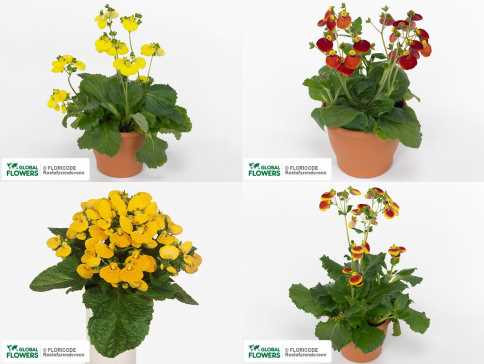
Proper watering is crucial for the health of your Calceolaria plant. Water the soil evenly, making sure it’s moist but not overly wet. Avoid both under-watering and over-watering. It’s best to water when the top inch of soil feels dry to the touch. Ensure effective drainage to prevent waterlogging.
Potting and Soil
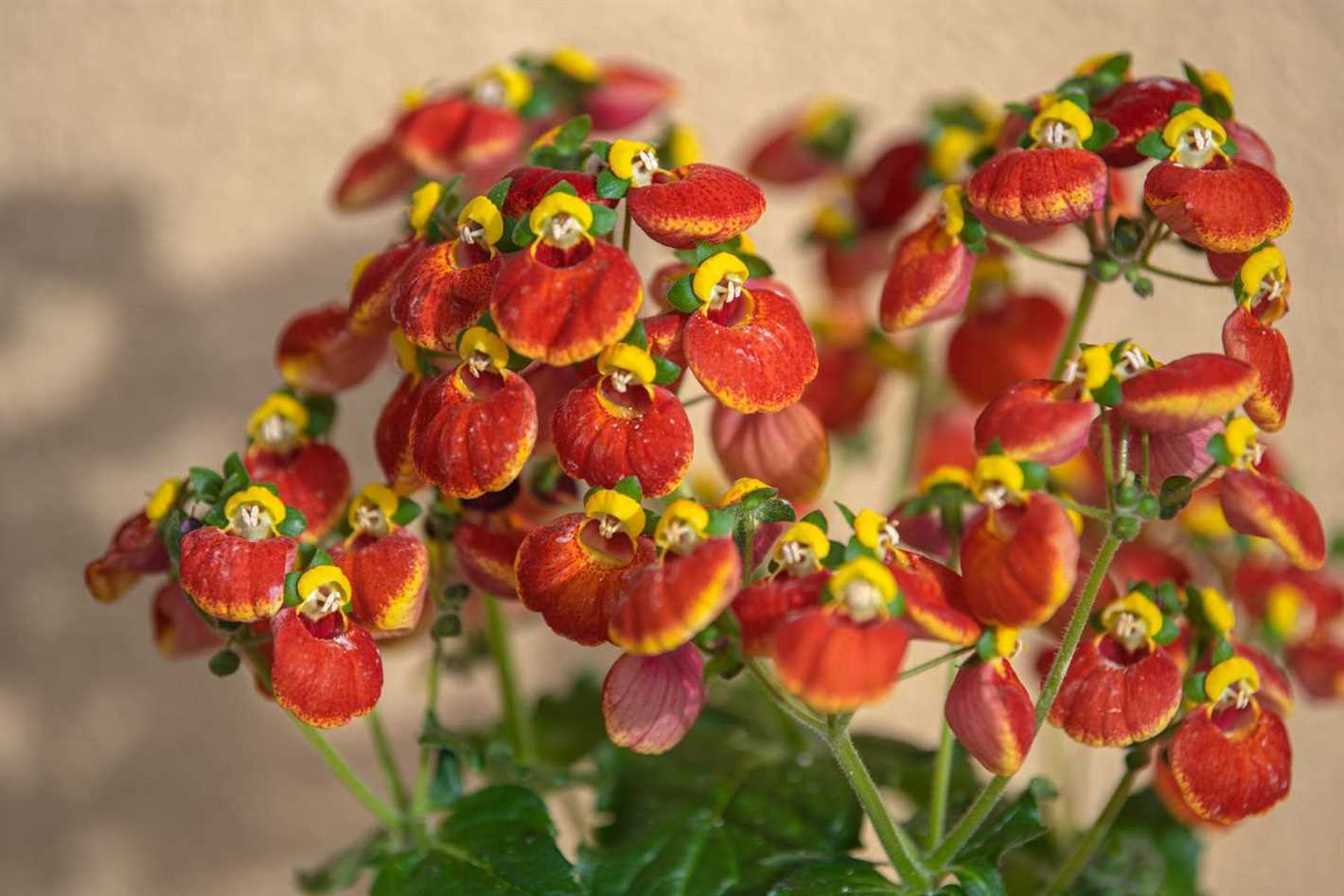
Use a well-draining potting mix that is rich in organic matter. The soil should have good moisture retention properties while allowing excess water to drain away. Repot your Calceolaria plant when necessary, typically during the spring season, using a pot that is slightly larger than its previous one.
Fertilizer
Feed your Calceolaria plant with a balanced water-soluble fertilizer once a month during the growing season. Dilute the fertilizer according to the manufacturer’s instructions. Avoid over-fertilizing, as it can lead to excessive foliage growth and reduce flower production.
Pruning
Regularly remove faded flowers to encourage new blooms and maintain the plant’s appearance. Use clean pruning shears to avoid the spread of diseases. Additionally, trim any leggy or overgrown stems to promote bushier growth.
Pest Control
Inspect your Calceolaria plant regularly for pests such as aphids, whiteflies, and spider mites. If you notice any infestation, use an appropriate insecticidal soap or horticultural oil to eliminate the pests. Don’t forget to check the undersides of leaves where pests often hide.
Managing Humidity
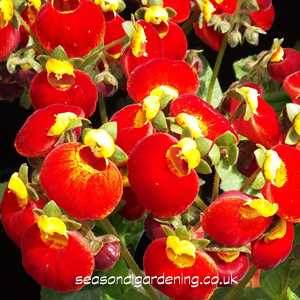
Calceolaria plants thrive in high humidity environments. Increase the humidity around the plant by misting it regularly with water or placing a tray filled with water and pebbles near the plant. Avoid misting the flowers directly to prevent water damage.
Different types of Calceolaria Plants
Calceolaria plants come in a wide variety of types, each with its own unique characteristics and growing requirements. Here are some popular types of Calceolaria plants:
1. Calceolaria Herbeohybrida
Also known as the Pocketbook plant or Slipper flower, Calceolaria Herbeohybrida is the most commonly cultivated type of Calceolaria. It features bright, vibrant flowers in shades of yellow, orange, red, and pink. These plants are typically grown as annuals and are popular choices for flower beds, containers, and hanging baskets.
2. Calceolaria Uniflora
Calceolaria Uniflora, also known as the Calceolaria Slipper Orchid, is a more delicate and exotic type of Calceolaria. It features small, intricate flowers that resemble a slipper or orchid. These plants are typically grown as perennials and are best suited for indoor cultivation or protected outdoor areas with mild climates.
3. Calceolaria Integrifolia
Calceolaria Integrifolia, also known as the Calceolaria Gold-dust, is a compact and bushy type of Calceolaria. It features small, rounded leaves covered in golden-yellow spots, giving it a unique and eye-catching appearance. These plants are typically grown as perennials and are well-suited for rock gardens, borders, and containers.
4. Calceolaria Insignis
Calceolaria Insignis, also known as the Calceolaria Jungle Queen, is a taller and more upright type of Calceolaria. It features large, showy flowers in shades of yellow, orange, and red. These plants are typically grown as annuals and are great choices for adding height and color to flower beds and borders.
5. Calceolaria Rugosa
Calceolaria Rugosa, also known as the Calceolaria Slipperwort, is a wild species of Calceolaria that is native to South America. It features small, yellow flowers with a distinctively wrinkled appearance. These plants are typically grown as perennials and are best suited for rock gardens, alpine gardens, and naturalized areas.
6. Calceolaria Crenatiflora
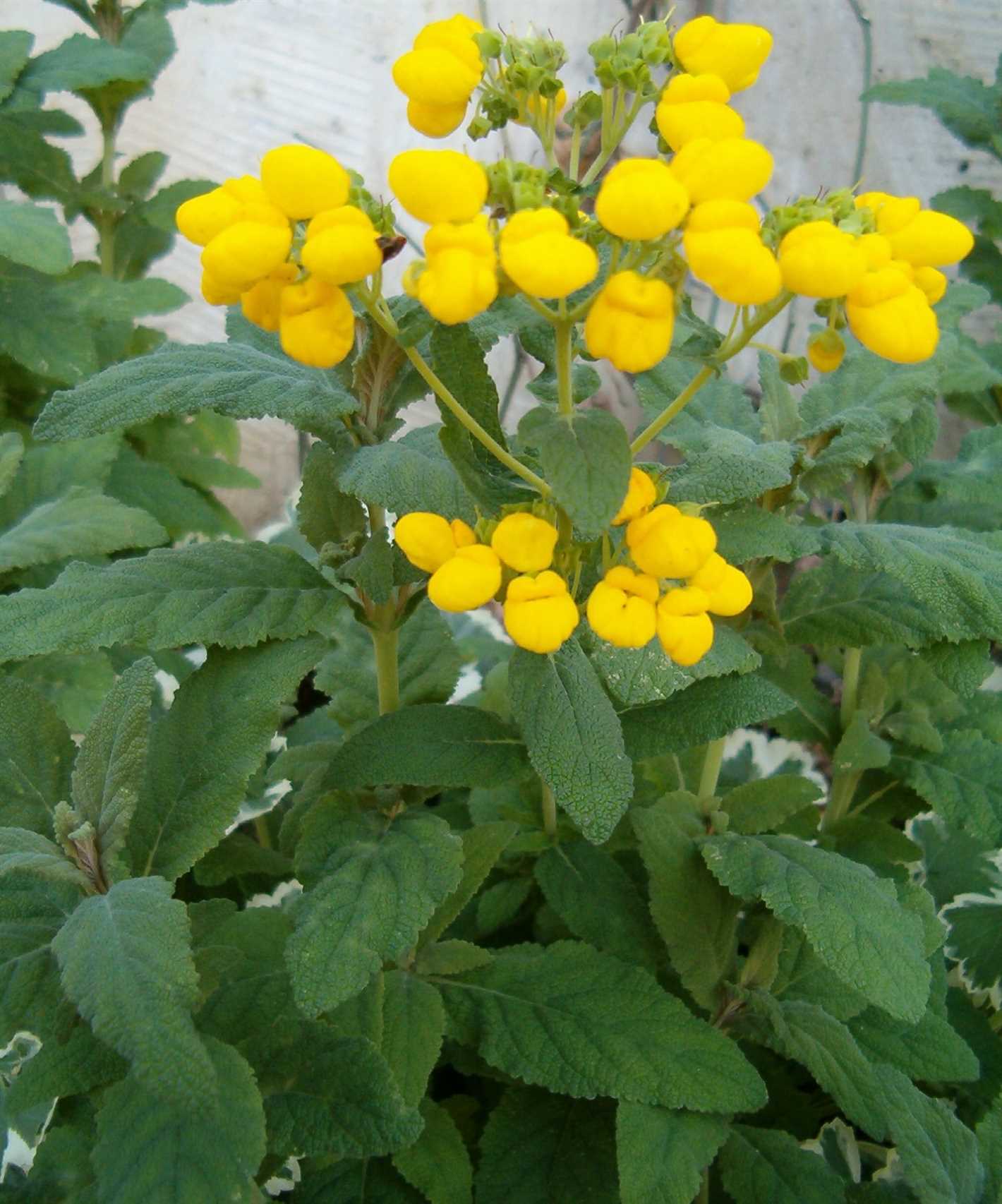
Calceolaria Crenatiflora, also known as the Calceolaria Lace-flower, is a delicate and lace-like type of Calceolaria. It features small, white or yellow flowers that are intricately patterned and fringed. These plants are typically grown as perennials and are popular choices for borders, containers, and hanging baskets.
These are just a few examples of the many types of Calceolaria plants available. Each type offers its own unique beauty and charm, so no matter which one you choose, you are sure to enjoy the stunning flowers and lovely foliage that Calceolaria plants have to offer.
Popular Varieties of Calceolaria
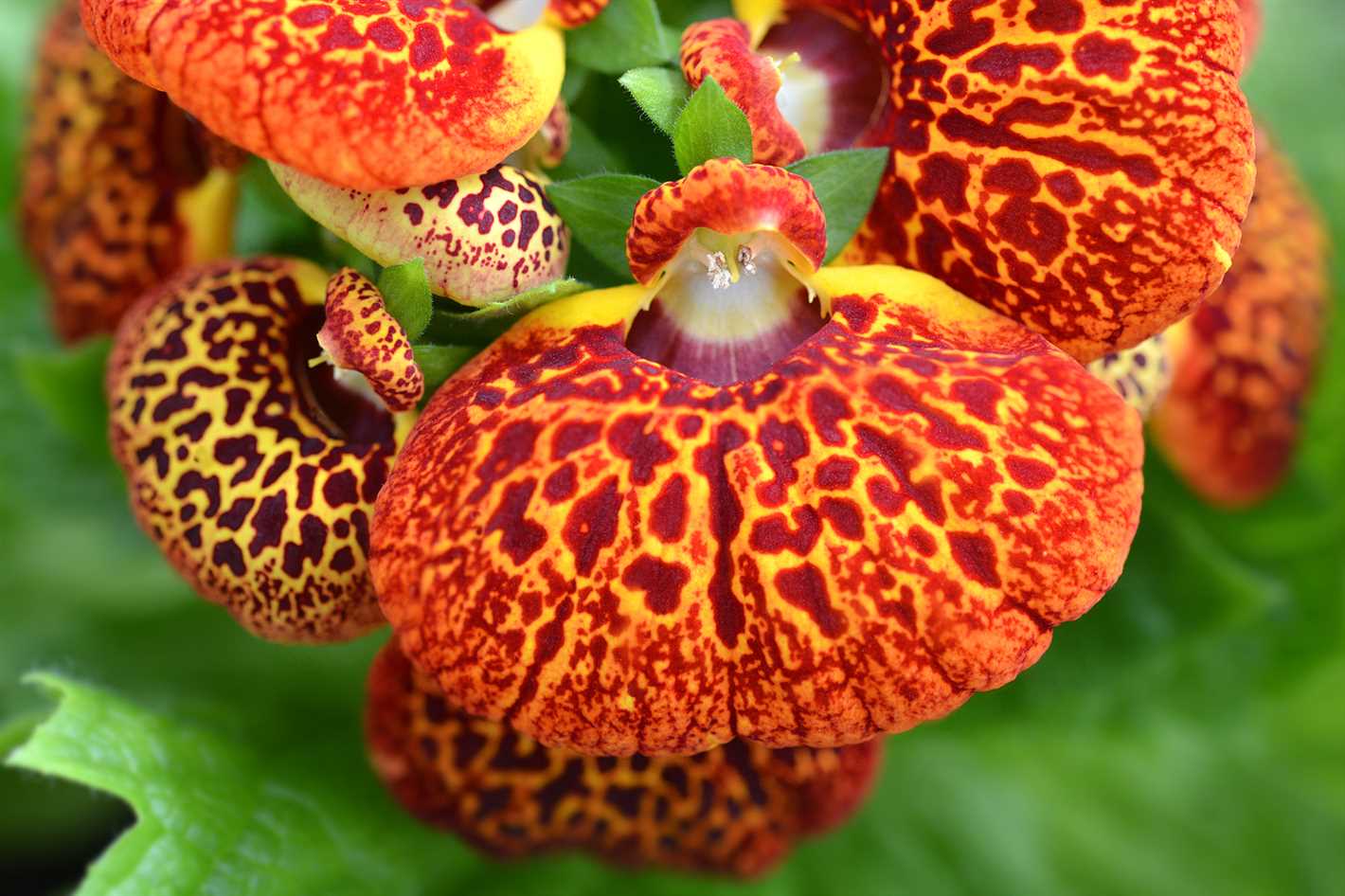
Calceolaria, also known as slipper flower, is a beautiful plant that comes in a variety of colors and forms. Here are some of the popular varieties:
- Calceolaria Herbeohybrida: This is the most common type of calceolaria. It features bright, vibrant flowers in a wide range of colors including yellow, orange, red, and pink.
- Calceolaria Uniflora: Also known as the Chilean Slipper Flower, this variety is native to the mountains of Chile. It has small, yellow flowers with distinct pouch-like shapes.
- Calceolaria crenatiflora: This variety is native to the Andes Mountains and features flowers in shades of yellow, orange, and red. The flowers have a unique fringed edge that adds to their beauty.
- Calceolaria integrifolia: Native to Argentina, this variety has flowers in shades of yellow and orange. It is known for its large, showy blooms and compact growth habit.
- Calceolaria arachnoidea: Also known as Woolly Slipper Flower, this variety has flowers that resemble small, fluffy balls. The flowers are usually yellow or orange in color.
These are just a few examples of the many varieties of calceolaria available. Each variety has its own unique characteristics and care requirements, so be sure to choose one that suits your gardening style and environment.
Calceolaria for Indoor Gardening
Calceolaria, also known as slipper flower or pocketbook plant, is a popular choice for indoor gardening. With its vibrant and unique flowers, it adds a touch of color and charm to any indoor space. Here’s a guide to growing and caring for Calceolaria plants indoors.
Light
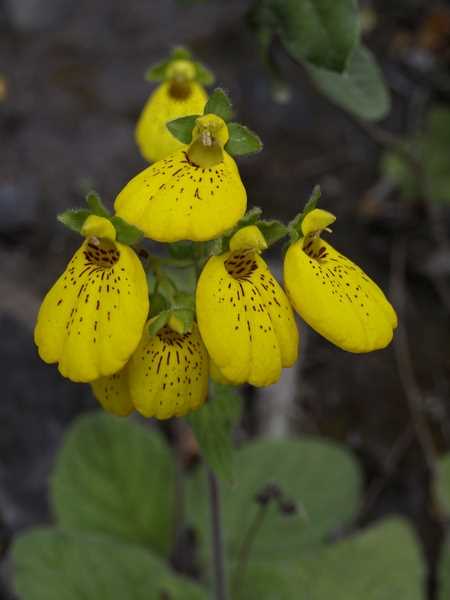
Calceolaria plants thrive in bright, indirect light. They prefer a location near a window that receives plenty of sunlight but avoid direct sunlight as it can scorch their delicate leaves. If your indoor space doesn’t receive sufficient natural light, you can supplement it with artificial grow lights.
Temperature
Calceolaria plants prefer cooler temperatures ranging from 50°F to 65°F (10°C to 18°C). They are not tolerant of extreme heat, so avoid placing them near heating vents or radiators. Maintaining a moderate temperature will help the plants thrive and prevent them from wilting.
Watering
Proper watering is essential for the health of Calceolaria plants. They prefer to be kept consistently moist, but not waterlogged. Allow the top inch of soil to dry out slightly before watering again. Be careful not to overwater as it can lead to root rot.
Fertilizer
Calceolaria plants benefit from regular fertilization during the growing season. Use a balanced, water-soluble fertilizer and dilute it to half-strength. Fertilize every two weeks to provide the necessary nutrients for healthy growth and vibrant flowers.
Humidity
Calceolaria plants appreciate higher humidity levels. To increase humidity around the plants, you can place a tray filled with water near them or use a humidifier. Misting the foliage with room temperature water also helps to maintain humidity.
Propagating
Calceolaria plants can be propagated by taking stem cuttings. Choose a healthy, non-flowering stem and cut it just below a node. Remove the lower leaves from the cutting and dip the cut end into rooting hormone. Plant the cutting in a well-draining potting mix and keep it consistently moist. After a few weeks, roots will develop, and you can transplant the cutting into its own pot.
Common Varieties
There are several different varieties of Calceolaria available for indoor gardening. Some popular choices include:
- Calceolaria arachnoidea: This variety has unusual web-like flowers and is known for its striking appearance.
- Calceolaria crenatiflora: With its vibrant red and yellow flowers, this variety is a standout in any indoor garden.
- Calceolaria uniflora: This compact variety produces small, dainty flowers and is perfect for smaller indoor spaces.
Conclusion
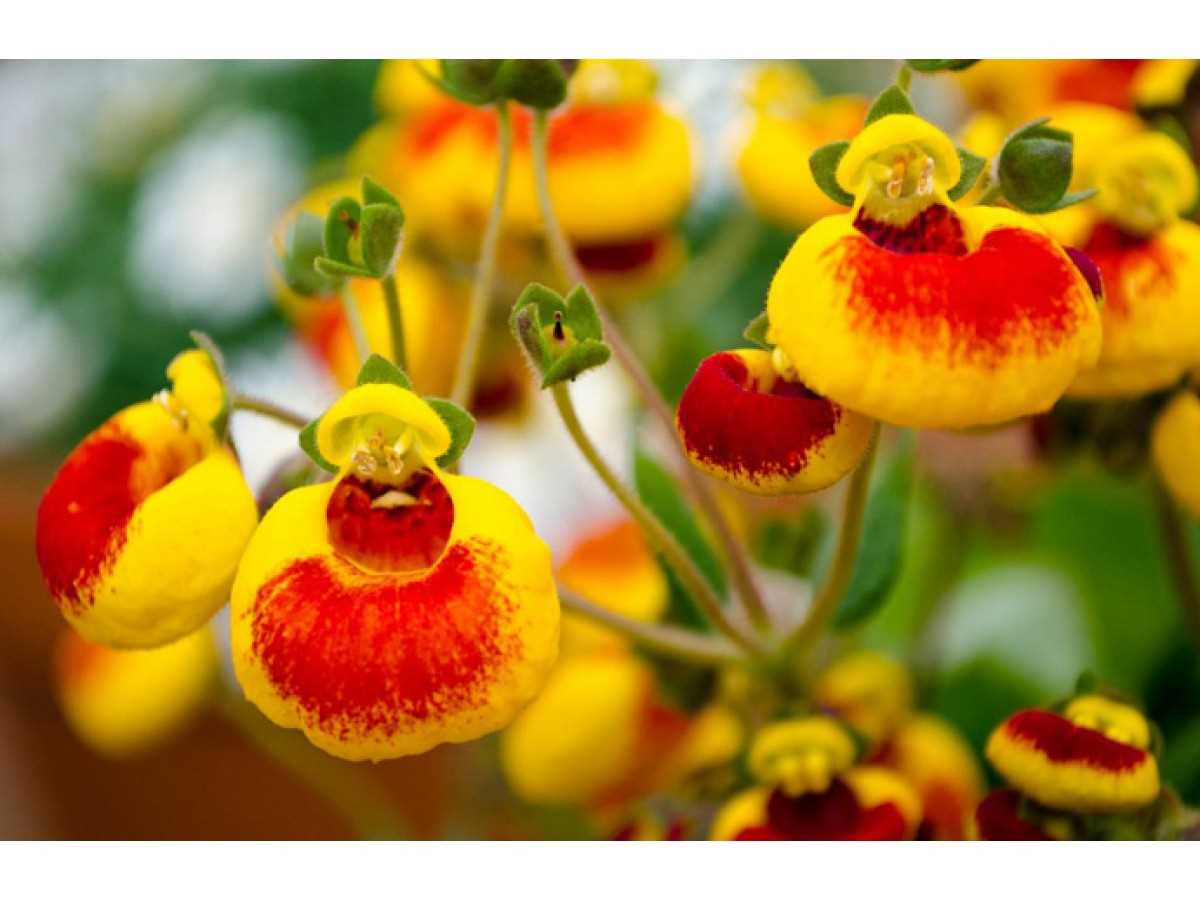
Calceolaria plants are a beautiful addition to any indoor garden. With the right care and conditions, they can thrive and reward you with their colorful flowers. Remember to provide them with the appropriate light, temperature, water, and humidity to ensure their success. Enjoy the beauty of Calceolaria plants in your indoor space!
Calceolaria for Outdoor Landscaping
If you’re looking to add a pop of color and unique texture to your outdoor landscape, Calceolaria plants are a fantastic choice. These vibrant flowering plants are sure to catch the eye and create a stunning visual display in any garden or landscape design.
Plant Types
Calceolaria plants come in various varieties, each offering its own unique characteristics. Some popular types that are commonly used for outdoor landscaping include:
- Calceolaria integrifolia: This variety produces large, showy flowers in shades of yellow, orange, and red. It is known for its long flowering period and hardy nature.
- Calceolaria herbeohybrida: Also known as pocketbook flower, this type features distinctive pouch-like flowers in bright colors such as yellow, orange, and pink. It is a popular choice for adding a touch of whimsy to outdoor landscapes.
- Calceolaria crenatiflora: This variety boasts flowers with frilly edges, creating a unique and eye-catching look. Colors range from yellow and orange to red and purple.
Outdoor Care
When growing Calceolaria outdoors, it’s important to consider their light, water, and soil requirements. Here are some key care tips:
- Light: Calceolaria plants thrive in partial shade or filtered sunlight. Avoid direct, intense sunlight, as it can scorch the leaves.
- Water: These plants prefer consistently moist but well-drained soil. Water regularly, especially during hot weather, but be careful not to overwater.
- Soil: Calceolaria plants prefer a well-draining soil that is rich in organic matter. A mix of peat moss, compost, and perlite can provide the perfect growing medium.
Landscaping Ideas
Calceolaria plants can be used in various ways to enhance your outdoor landscape design. Here are some ideas:
- Create colorful borders: Plant Calceolaria along walkways or around garden beds to add vibrant color and create a beautiful border.
- Container gardening: Grow Calceolaria in decorative pots or containers and place them strategically around your outdoor space for an instant burst of color.
- Rock gardens: These plants are well-suited for rock gardens, thanks to their ability to thrive in well-draining soils and their compact growth habit.
- Combine with other plants: Pair Calceolaria with other flowers, grasses, or shrubs that complement their colors and textures for a visually appealing landscape.
Remember, Calceolaria plants are not frost-tolerant, so it’s important to protect them during the winter months or consider them as annuals in colder climates. With proper care and placement, Calceolaria can be a stunning addition to any outdoor landscaping project.
Q&A:
What is Calceolaria?
Calceolaria is a flowering plant that belongs to the Scrophulariaceae family. It is commonly known as slipper flower or pocketbook flower due to its unique shape.
What are the types of Calceolaria?
There are several types of Calceolaria, including Calceolaria herbeohybrida, which is a popular houseplant, and Calceolaria uniflora, which is commonly found in the Andes Mountains of South America.
What are the care tips for Calceolaria?
To take care of Calceolaria, it is important to place it in a bright location with indirect sunlight. It requires well-draining soil and regular watering. The plant should be kept moist but not waterlogged. It also benefits from regular feeding with a balanced fertilizer.
Can Calceolaria be grown indoors?
Yes, Calceolaria can be grown indoors. It is a popular houseplant due to its colorful flowers and compact size. However, it requires specific care, including proper lighting and watering, to thrive indoors.
How often should I water Calceolaria?
Calceolaria should be watered regularly, keeping the soil moist but not overly wet. It is important to avoid both underwatering and overwatering, as it can lead to root rot or wilting of the plant.
Are there any common problems or pests that affect Calceolaria?
Yes, Calceolaria can be susceptible to pests such as aphids, whiteflies, and mealybugs. It can also be prone to diseases like powdery mildew and botrytis. Regular inspection and proper hygiene can help prevent and control these problems.
What are some popular varieties of Calceolaria?
Some popular varieties of Calceolaria include Calceolaria integrifolia, which has yellow flowers, and Calceolaria corymbosa, which has red and yellow flowers. Other varieties like Calceolaria mexicana and Calceolaria uniflora also have their own unique characteristics.
Video:
How To Prune Tomato Plants For Maximum Yield & Bigger Tomatoes – Organic Vegetable Garden in Arizona







